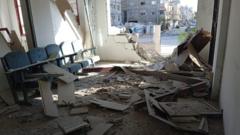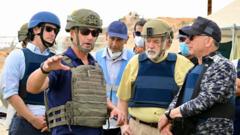The aftermath of military operations in Gaza has unveiled a grave public health crisis stemming from asbestos exposure in the city’s rubble, posing long-term dangers alongside immediate threats from ongoing violence.**
Unseen Dangers: The Asbestos Hazard in Gaza's Post-Conflict Ruins**

Unseen Dangers: The Asbestos Hazard in Gaza's Post-Conflict Ruins**
As Gaza emerges from conflict, the risk posed by contaminated rubble laden with asbestos threatens the health of millions.**
The recent military actions in Gaza have not only ravaged the territory's infrastructure but have also unearthed a hazardous threat: asbestos, a notorious silent killer. This mineral, which once found widespread use in construction materials, releases dangerous fibers that become airborne when disturbed, leading to severe respiratory illnesses and various forms of cancer over time. Despite the global prohibition of asbestos, its prevalence in older structures remains a significant concern, particularly within Gaza’s densely populated urban refugee camps established for Palestinians displaced during the 1948-1949 Arab-Israeli conflict.
A startling report from the United Nations Environment Programme (UNEP) estimates that approximately 2.3 million tons of rubble across Gaza may be tainted with asbestos contaminants. Professor Bill Cookson, the director of the National Centre for Mesothelioma Research in London, describes the current environment in Gaza as alarmingly toxic, stating, “People are going to suffer acutely… but also in the longer term.” The implications of exposure can remain dormant for decades—often surfacing as debilitating diseases like mesothelioma or asbestosis many years after initial contact with the fibers.
This dire situation is compounded by the ongoing military activities. Inhalation of asbestos fibers occurs when they are released into the air due to events such as airstrikes. With fibers imperceptibly small to the naked eye, they easily infiltrate the lungs, leading to chronic medical conditions. Dr. Ryan Hoy, who has researched the consequences of dust inhalation, emphasizes the challenge of avoiding these hazardous particles, particularly given Gaza’s high population density of around 2.1 million inhabitants within a mere 365 square kilometers—about a quarter of London's area.
While public health officials express concerns over the long-term ramifications of asbestos exposure, immediate threats from ongoing military assaults dominate the minds of Gaza’s civilians. Chiara Lodi, medical co-ordinator for the NGO Medical Aid for Palestinians, notes that local populations are prioritizing survival amid airstrikes over potential long-term health risks from airborne asbestos. This lack of awareness further hampers any preventive measures against inhalation of hazardous dust.
Historically, asbestos has been a known danger, linked to various forms of cancer including lung, laryngeal, and ovarian cancers—effects associated with both exposure to asbestos and the inhalation of silica dust found in concrete debris. As the reconstruction efforts in Gaza commence, experts warn that asbestos’s resilience, the very quality that made it popular in construction, complicates safe removal practices, potentially increasing the exposure risk for the population.
Despite bans on asbestos in numerous countries—including Israel in 2011—efforts to clear contaminated debris could take over two decades and potentially cost up to $1.2 billion. As it stands, more than 53,000 Palestinian fatalities have arisen from the recent military operations according to local health ministry reports, surpassing the immediate death toll of direct conflict—underscoring the need to address both the acute and chronic dangers posed to those living amidst the rubble of their former homes.
A startling report from the United Nations Environment Programme (UNEP) estimates that approximately 2.3 million tons of rubble across Gaza may be tainted with asbestos contaminants. Professor Bill Cookson, the director of the National Centre for Mesothelioma Research in London, describes the current environment in Gaza as alarmingly toxic, stating, “People are going to suffer acutely… but also in the longer term.” The implications of exposure can remain dormant for decades—often surfacing as debilitating diseases like mesothelioma or asbestosis many years after initial contact with the fibers.
This dire situation is compounded by the ongoing military activities. Inhalation of asbestos fibers occurs when they are released into the air due to events such as airstrikes. With fibers imperceptibly small to the naked eye, they easily infiltrate the lungs, leading to chronic medical conditions. Dr. Ryan Hoy, who has researched the consequences of dust inhalation, emphasizes the challenge of avoiding these hazardous particles, particularly given Gaza’s high population density of around 2.1 million inhabitants within a mere 365 square kilometers—about a quarter of London's area.
While public health officials express concerns over the long-term ramifications of asbestos exposure, immediate threats from ongoing military assaults dominate the minds of Gaza’s civilians. Chiara Lodi, medical co-ordinator for the NGO Medical Aid for Palestinians, notes that local populations are prioritizing survival amid airstrikes over potential long-term health risks from airborne asbestos. This lack of awareness further hampers any preventive measures against inhalation of hazardous dust.
Historically, asbestos has been a known danger, linked to various forms of cancer including lung, laryngeal, and ovarian cancers—effects associated with both exposure to asbestos and the inhalation of silica dust found in concrete debris. As the reconstruction efforts in Gaza commence, experts warn that asbestos’s resilience, the very quality that made it popular in construction, complicates safe removal practices, potentially increasing the exposure risk for the population.
Despite bans on asbestos in numerous countries—including Israel in 2011—efforts to clear contaminated debris could take over two decades and potentially cost up to $1.2 billion. As it stands, more than 53,000 Palestinian fatalities have arisen from the recent military operations according to local health ministry reports, surpassing the immediate death toll of direct conflict—underscoring the need to address both the acute and chronic dangers posed to those living amidst the rubble of their former homes.
















